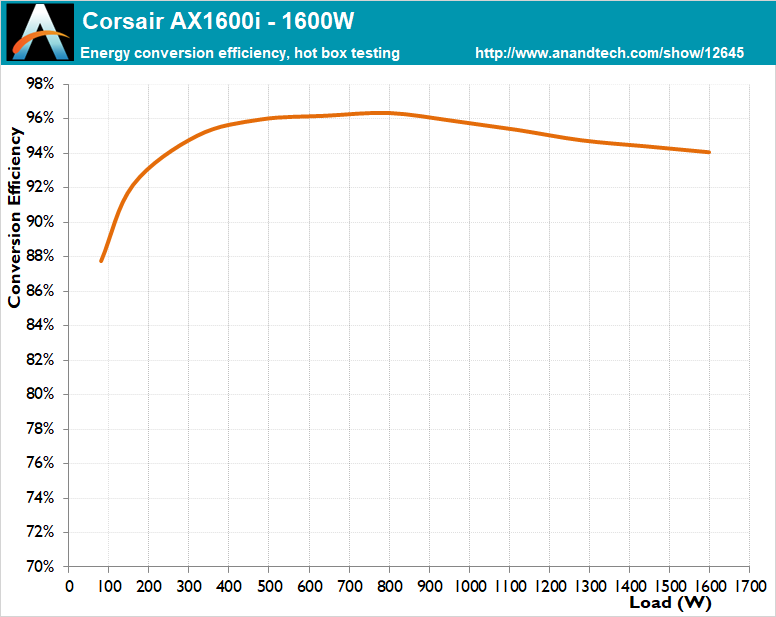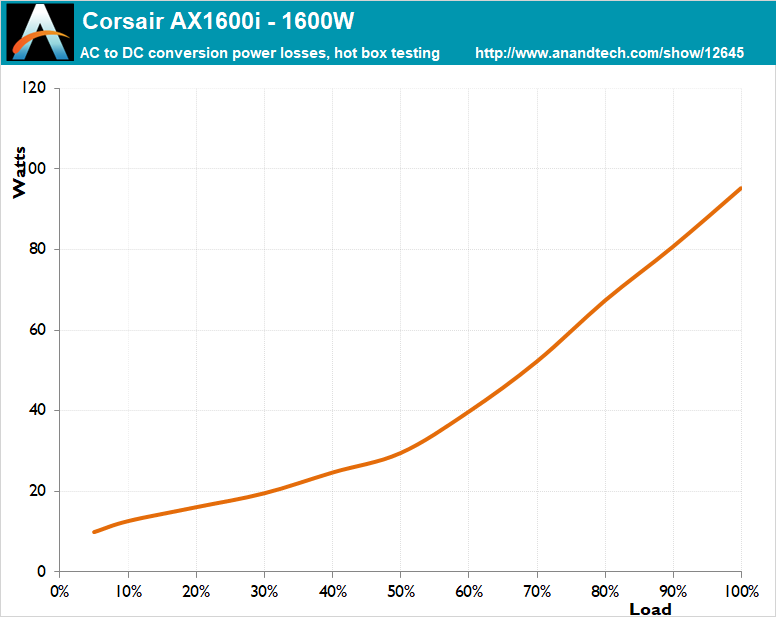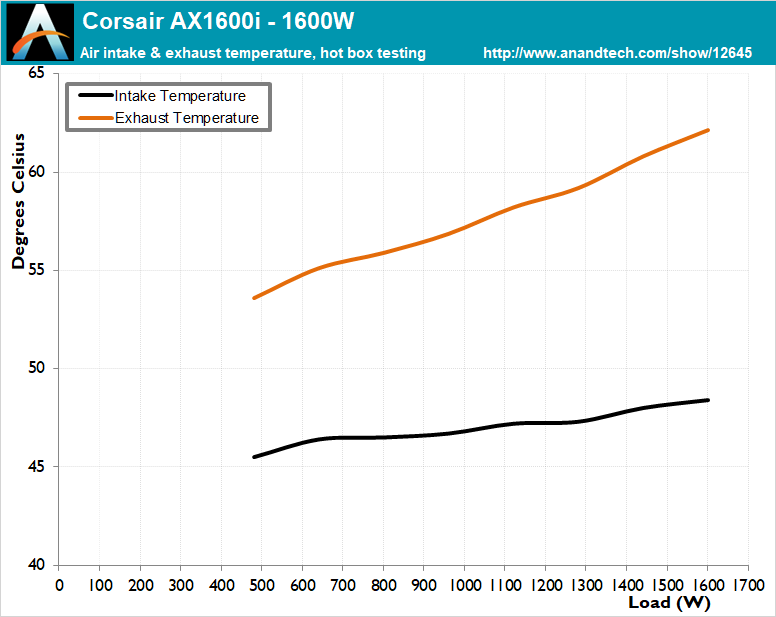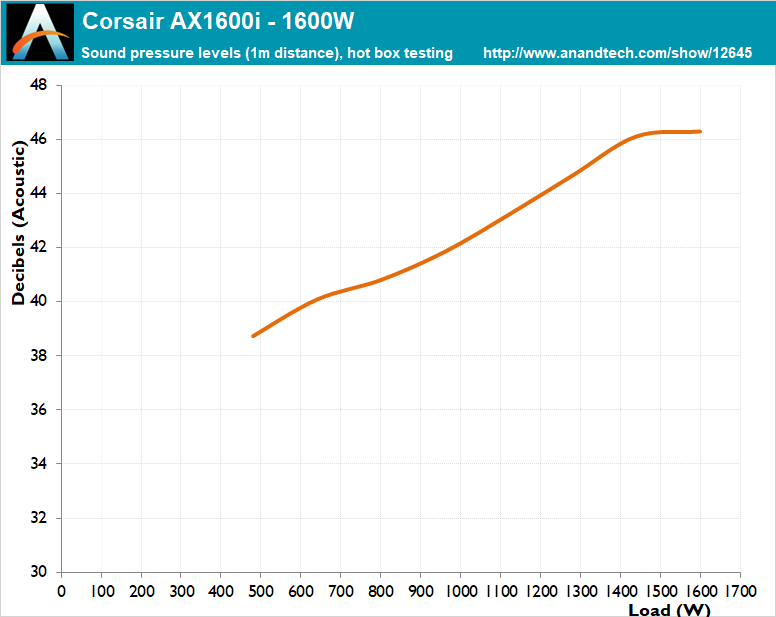The Emperor of Efficiency: Corsair's AX1600i PSU Rules Alone (Review)
by E. Fylladitakis on April 18, 2018 9:30 AM ESTHot Test Results
The Corsair AX1500i already was the benchmark of electrical quality, leaving very little room for improvement. Although the AX1600i might appear to deliver a little bit better power quality, the truth is that we would need very high precision equipment to tell the difference between the two, and any difference would be unimportantly small. However, that does not lessen the fact that the AX1600i delivers possibly the best power quality that can be bought at this point of time. For the most part, the voltage ripple of any line is less than ten millivolts. The maximum ripple on the 12V line is just 14 mV and that is with a massive current draw of almost 124 amperes. The voltage regulation is equally impressive, with a variation of just 0.2% on the 12V line across the nominal load range. Voltage regulation is a little bit worse on the 3.3V/5V lines, at 0.4%/0.25% respectively, which figures still are a lot better than what most current high-performance PSUs can achieve.
| Main Output | ||||||||
| Load (Watts) | 321.91 W | 804.24 W | 1205.17 W | 1606.8 W | ||||
| Load (Percent) | 20.12% | 50.26% | 75.32% | 100.42% | ||||
| Amperes | Volts | Amperes | Volts | Amperes | Volts | Amperes | Volts | |
| 3.3 V | 2.78 | 3.33 | 6.96 | 3.33 | 10.44 | 3.31 | 13.92 | 3.31 |
| 5 V | 2.78 | 5.05 | 6.96 | 5.05 | 10.44 | 5.04 | 13.92 | 5.03 |
| 12 V | 24.74 | 12.07 | 61.85 | 12.06 | 92.78 | 12.05 | 123.71 | 12.05 |
| Line | Regulation (20% to 100% load) |
Voltage Ripple (mV) | |||||
| 20% Load | 50% Load | 75% Load | 100% Load | CL1 12V |
CL2 3.3V + 5V |
||
| 3.3V | 0.4% | 6 | 10 | 12 | 12 | 4 | 10 |
| 5V | 0.25% | 4 | 6 | 10 | 10 | 6 | 12 |
| 12V | 0.2% | 6 | 8 | 10 | 14 | 12 | 6 |
When it comes to adverse ambient conditions, the Corsair AX1600i is a true fortress. Operating the AX1600i inside our hotbox had virtually no impact on its electrical performance and/or efficiency. Even though the ambient temperature was well over 45 °C, the efficiency drop across the entire range was a mere 0.1%. This suggests that the components of the AX1600i are far from getting thermally overstressed, even with the PSU operating at maximum output under these adverse conditions.
The only thing inside the AX1600i that is affected by the high ambient temperature is the cooling fan. It will still not even start with a load below 460 Watts but it is livelier once it does start, increasing its speed at a higher rate as the load increases. It ultimately reaches about 45.5 dB(A) at maximum load, which would be a low figure even for a mainstream PSU with an output of some hundred Watts, yet the AX1600i manages to maintain comfortable noise levels operating at maximum load with an ambient temperature of over 48°C. The internal temperatures of the PSU also are very low taking its power output and low fan speed into account.















39 Comments
View All Comments
bill.rookard - Wednesday, April 18, 2018 - link
Ideally, a proper sized PSU is double the wattage of the total of everything running full tilt. All PSUs hit their max efficiency at 50% load, so if you have a 100w CPU, a single 150w GPU, add in a few HDDs/SSDs (10w each) and motherboard (50w), your average single GPU/CPU system will be 300-350w. Double that is 600-700w. So on average (since most people have a similar config) that should be the most popular size.I can't even imagine a system which would be pulling 800-900w directly. I could probably do it with my computer which I do the folding on (Xeon 3470 @ 4.2ghz, Asus P7F7E-WS) which could easily do a quad-SLI setup... but I'd have to get a quad set of 1070's or 1080's to break 900w nominal.
DanNeely - Wednesday, April 18, 2018 - link
You only want double max if your computer is almost always running at full load. IF you're not folding/mining/etc 24/7 and leave it on at idle you're paying a very large efficiency penalty most of the time. The low draw side of the efficiency curve is much worse than the high draw one (it's driven by fixed wattage loads vs the conversion efficiency that sets the peak, and temperature penalty that causes the slow drop off at max). In those cases 30-50% over will hit the sweet spot for efficiency, and if you have cheap power and don't load it a lot 15-20% may have the lowest total cost of ownership. You don't want to go much below that because running at maximum load also puts maximum stress levels on the PSU which will lead to faster aging and earlier death. (If you were foolish enough to get a no-name PSU loading it to just under max and keeping it there might let the magic smoke out if the number they put on the box is a peak power draw limit not a sustained power draw limit like it is in any half decent model.)zodiacfml - Thursday, April 19, 2018 - link
Correctnowwhatnapster - Friday, April 20, 2018 - link
Corsair link shows 700-725 watts pull for a Ryzen 1800x, 2x 1080ti ftw3, 1 ssd, 4x noctua case fans, stock clocks. @96% efficiencyA quad setup (although technically unsupported on 10xx series) would be closer to 1100w
Holliday75 - Wednesday, April 18, 2018 - link
Why does it feel like people purposely misunderstand the purpose of this product and the review posted here?This is a Formula One race car where new technologies are tested, showcased and pushed to the extreme. Eventually it will filter down to the every day drivers we use. Very few people in the world NEED this product. This is the test bed for proof of concept for the consumer market. It is what it is. Its cool and exciting to see a glimpse into what the market can become down the road.
The_Assimilator - Wednesday, April 18, 2018 - link
Thank you.jonnyGURU - Wednesday, April 18, 2018 - link
Well said. Right now, the technology used doesn't scale economically. Would you pay 1600W pricing for a 500W PSU?mtnmanak - Tuesday, April 24, 2018 - link
Well, to be fair, micro-USB?My old flip phone called and wants its USB port back.
modeonoff - Wednesday, April 18, 2018 - link
All sold out and in back order. Nobody knows when there will be stock again. Corsair has no comment :-(nowwhatnapster - Friday, April 20, 2018 - link
I got one in March for 450 direct from corsair. Had to stalk their website for several weeks. Scalpers are buying them up like GPU's and reselling them on ebay with crazy markup.Logistics aside, very happy with the PSU. Had a hx850 running at full tilt powering 2x1080ti and ryzen 1800x. The ax1600i barely breaks a sweat. About 700-725 watts at full load and stock clocks. Exhaust temps are much lower and zero fan noise from the PSU. If you factor in the 10 year warranty, it's a worthwhile investment. Now my PSU is operating at near peak efficiency. Over the life of the PSU the efficiency gains should offset the high initial cost.
I did not like the cables that came with the PSU. They are extremely ridged, especially the 24pin with its shrink wrapped inline capacitors. I opted to shell out for the premium sleeved cables which are much more flexible and aesthetically pleasing.